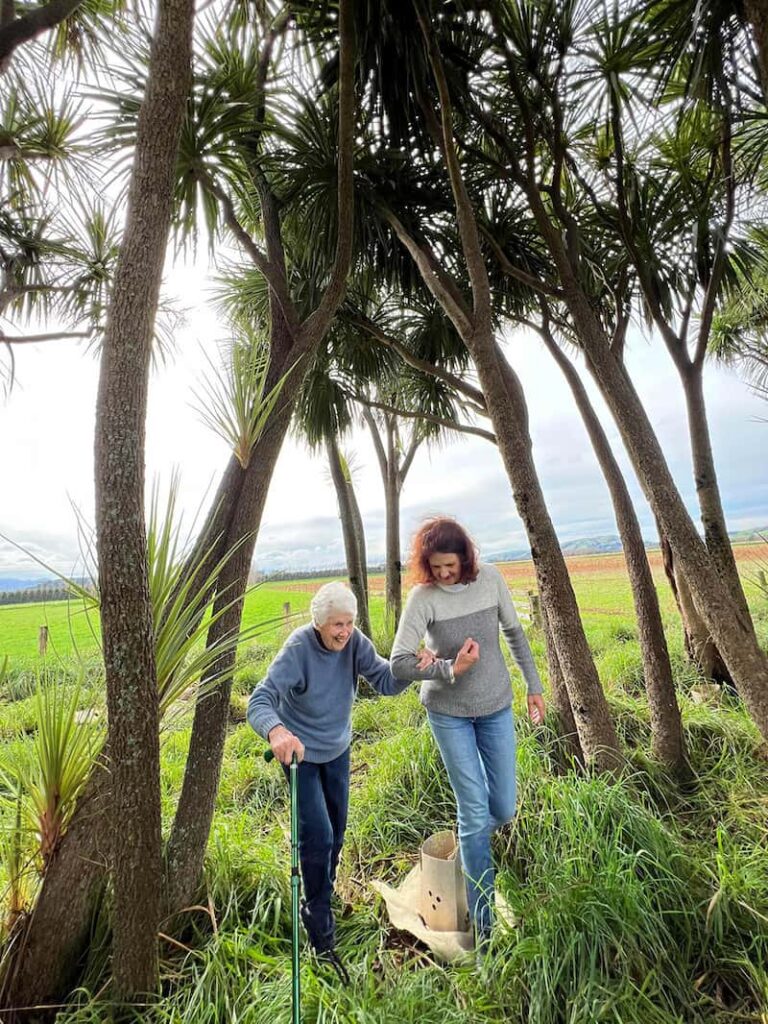Written by Yvonne Riddiford
Celebrating my 98th birthday provided an opportunity to reflect on aspects of time and changing attitudes towards land. Without a doubt the involvement with my daughters over the years has given me a different perspective on our relationship to land and race which I may not have got to on my own. We live in a time now when our relationship with Māori and the land is being more closely scrutinised than it has ever been before. This has made me more conscious of the divisions that exist. I grew up in the King Country and Māori, mainly from the local Otewa Pa, lived and worked with us on the farm and like my parents I had good relationships with them. The mistreatment and misunderstanding that I have come to recognise as a fact wasn’t in my awareness back then.
Getting old has given me a perspective on time and how worldviews and attitudes can change. It was literally this year that I realised with amazement that I was born only fifteen years after my father had started clearing the bush. Fifteen years seems nothing at all now. My father, Spencer Westmacott had gone to the King Country as a pioneer in 1910 to find land, which at the time was more affordable than in South Canterbury where he had grown up. The thinking was that land that could grow such mighty trees must be very fertile. He leased a block of land from the Māori King Mahuta and subsequently bought land which ran from the higher slopes of Rangitoto mountain to the Waimahora valley floor. Over five years he cleared the bush with forestry gangs. He was on good terms with Te Ngoi Maika, the chief from the Otewa Pa, where he always stayed the night on the way to the farm, which became known as Rangitoto. If my father needed help it would often come through the Pa. Then the first world war came. Dad was gravely wounded on the first day of fighting at Gallipoli; no one thought he would ever farm again. However fifteen years later it was obvious the farm was suffering from neglect and needed him to be on the spot.
Now married, with one arm and a stiff leg, Dad left Christchurch where he had been living a relatively easy life on his war pension. He returned to the King Country with my mother and three small children. As a child the hillsides that towered over the house had been cleared and burnt and my recollection is of the fern struggling to take over with wineberry, “mother of the bush”, as the first tree to regenerate in the gullies. Everywhere stood the tall, ghostly, half burnt skeletons of the forest giants; rata, rimu and totara, which had withstood the original burn. They were to remain a distinctive part of the landscape for many years to come.

What is so interesting to me looking back is the total change that has come about in our relationship to land. Back then, good management meant clearing and turning everything into pasture. Now across the country, huge efforts are being made to restore native bush; except of course in the vast tracts of land that have been put into Pinus radiata. Like many, I invested in a pine forest in the North Wairarapa lowland thirty years ago. At the time I felt some contradiction and was a little uneasy. The same effort that had been made in putting land into pasture was now going into wide scale conversion into radiata; a tree so much inferior to the forest of its original cover.
Now at the end of my life I have come to understand more clearly than I did, that a regenerative approach does not mean total control; nor does it mean leaving the land completely to its own devices, but rather working in partnership with the land. On our farm here in the South Wairarapa we are fortunate that over the centuries the loops of the Ruamāhanga river meandering across the valley floor have left not only fertile soils, but the footprints of where wetlands would have been. When I was a geography student at Canterbury University, the primary text book was Geomorphology by Christopher Cotton. He describes the geomorphic story that shaped the land. The folds in the land created by the river have suggested how we might proceed with the wetland native plant restoration for Ruamāhanga Mauri oho. I feel fortunate that I have lived long enough to see the wheel turning in a new direction and to now be part of a growing ambition to listen and learn from the river and the land.

Yvonne and Belinda Cranswick in the Tī kōuka grove on a 2023 volunteer day